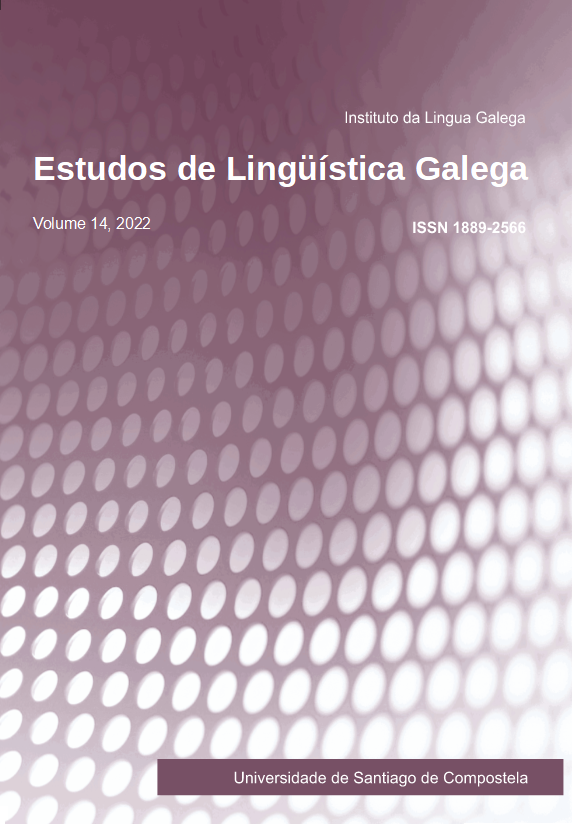On the place of gender in Galician grammar
Main Article Content
Abstract
This paper explores the syntactic nature of gender in Galician nouns. Gender in Galician is neither a morpheme nor a kind of meaning, but an inherent morphosyntactic category whose function it is to establish agreement structures. This fact introduces gender into the syntactic representation of words, making it necessary to consider it an inflectional category. In some nouns which denote animate beings, such as neno ~ nena (‘boy’ ~ ‘girl’) or lobo ~ loba (‘male wolf’ ~ ‘female wolf’), there is a productive link between syntactic information about grammatical gender and conceptual information about sexual identity that might be formulated in terms of rules of lexical derivation, yet I argue that this does not affect the basically syntactic and inflectional nature of the category. In support of this position I analyze the behaviour of gender under so-called gender neutralization, which I show to be a semantic, not a syntactic or inflectional process.
Keywords:
Article Details
References
Alarcos Llorach, Emilio (1994): Gramática de la lengua española. Madrid: Espasa Calpe.
Álvarez, Rosario / Xosé Luís Regueira / Henrique Monteagudo (1986): Gramática galega. Vigo: Galaxia.
Álvarez, Rosario / Xosé Xove (2002): Gramática da lingua galega. Vigo: Galaxia.
Ambadiang, Théophile (1999): “Capítulo 74. La flexión nominal. Género y número”, en Ignacio Bosque / Violeta Demonte (eds.) Gramática descriptiva de la lengua española. Volumen 3. Entre la oración y el discurso. Morfología. Madrid: Espasa Calpe, 4843-4913.
Anderson, Stephen R. (1988): “Morphological theory”, en Frederik J. Newmeyer (ed.) Linguistics: the Cambridge survey. Vol. 1. Linguistic theory: foundations. Cambridge: CUP, 146-191.
Anderson, Stephen R. (1992): A-morphous morphology. Cambridge: CUP.
Aronoff, Mark (1994): Morphology by itself. Stems and inflectional clases. Cambridge, Massachusetts: The MIT Press.
Beard, Robert (1987): “Morpheme order in a lexeme/morpheme-based morphology”, Lingua 72, 1-44.
Booj, Gert (1994): “Against split morphology”, en Yearbook of Morphology 1993, 27-50.
Bybee, Joan L. (1985): Morphology: a study of the relation between meaning and form. Amsterdam: John Benjamins.
Culicover, P. W. / Ray Jackendoff (2005): Simpler Syntax. Oxford: OUP.
Jackendoff, Ray (2002): Foundations of Language. Oxford: OUP.
Lagares, Xoán Carlos (2000): “Algunhas consideracións sobre o xénero gramatical e o sexismo lingüístico en galego”, Revista galega de filoloxía 1, 67-96.
Lagares, Xoán Carlos (2001): “O xénero gramatical: entre o léxico e a gramática”, en Xosé Luís Regueira / Alexandre Veiga (eds), Da gramática ó diccionario. Estudios de lingüística galega. Santiago de Compostela: USC, 173-183.
Lagares, Xoán Carlos (2003): O xénero gramatical en galego. A Coruña: UDC.
Machado, J. P. (1971): Dicionário etimológico da língua portuguesa. Lisboa: Livros Horizonte.
Matthews, Peter H. (1991): Morphology. Cambridge: CUP.
Roca, Iggy (2005): “La gramática y la biología en el género del español (1.ª parte)”, en Revista Española de Lingüística 35/1, 17-44.
Roca, Iggy (2006): “La gramática y la biología en el género del español (2.ª parte)”, en Revista Española de Lingüística 35/2, 397-432.
Stump, Gregory T. (1998): “Inflection”, en Andrew Spencer / Arnold Zwicky (eds.) The handbook of morphological theory. Oxford: Blackwell, 13-43.
Villalva, Alina (2000) Estruturas morfológicas. Unidades e Hierarquias nas Palavras do Português. Lisboa: Fundaçao Calouste Gulbenkian e Ministérios de Ciência e Tecnologia.
Most read articles by the same author(s)
- Francisco Dubert Garcia, Rio-Torto, Graça / Alexandra Rodrigues / Isabel Pereira / Rui Pereira / Silvia Ribeiro (2013): Gramática derivacional do Português. Coimbra: Imprensa da Universidade de Coimbra, 512 pp. , Estudos de Lingüística Galega: Vol 6 (2014)
- Francisco Dubert García, Florentina Xoubanova Montero, Bibliografía 2013 , Estudos de Lingüística Galega: Vol 7 (2015)
- Francisco Dubert García, Florentina Xoubanova Montero, Bibliografía 2014 , Estudos de Lingüística Galega: Vol 8 (2016)
- Francisco Dubert García, Florentina Xoubanova Montero, Bibliografía 2015 , Estudos de Lingüística Galega: Vol 9 (2017)
- Francisco Dubert García, Viejo Fernández, Xulio. 2022. La llingua n’Asturies al traviés de los sieglos, Xixón: Conseyería de Cultura, Política Llingüística y Turismu / Ministerio de Cultura y Deporte / Ediciones Trea [197 pp.]. ISBN: 978-84-19525-29-1. , Verba: Anuario Galego de Filoloxía: Vol 51 (2024)


